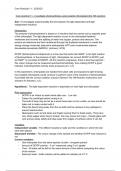Exam (elaborations)
CP11 write up -Investigate photosynthesis using isolated chloroplasts (the Hill reaction)
- Module
- Core Practicals
- Institution
- PEARSON (PEARSON)
Edexcel A Biology A level core practical Write ups. All include an introduction, hypothesis, variables, method, results, evaluations... CP11 -Investigate photosynthesis using isolated chloroplasts (the Hill reaction)
[Show more]



